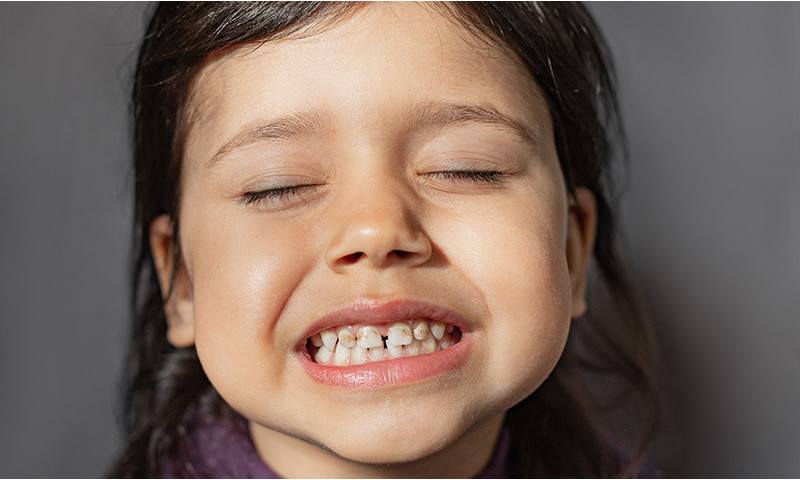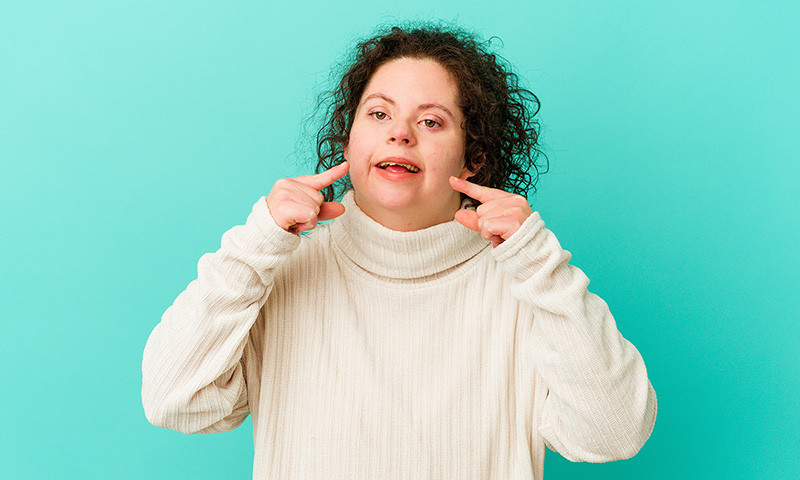Key facts in short
- Definition: Chalky teeth are a condition affecting the tooth enamel development of the adult teeth.
- Symptoms: The teeth are already crumbly, discoloured and hypersensitive when they erupt. The tooth enamel is much softer than normal.
- Causes: The exact causes are not yet fully known.
- Treatment: Since there is an increased risk of caries, or dental decay, adopting effective preventive measures is extremely important. Dental sealants, crowns and fillings help boost the stability of the tooth and reduce sensitivity. In the most severe and painful forms of the condition, chalky teeth may need to be extracted.
- Preventative measures: Since the exact causes of chalky teeth are not yet known, we can only make assumptions regarding preventive measures.
Definition: What are chalky teeth?
Normally, tooth enamel is the hardest material in the human body. It forms around the dentine to protect it from caries and other external influences. However, chalky teeth are manifested clinically as a disturbance of the tooth enamel: It contains an insufficient amount of hydroxyapatite, which ultimately leads to disrupted enamel hardening.
The teeth of people suffering from this condition are ten times softer than normal teeth and thus particularly sensitive. Further, the teeth may be crumbly; often with minor structural defects, such as grooves, furrows and discolourations. The condition can even cause the tooth enamel to crack. Since the protective effect of the tooth enamel is severely compromised, the teeth are particularly susceptible to dental decay. The porous surface is the ideal breeding ground for bacteria.
Chalky teeth are referred to in technical terms as molar incisor hypomineralisation (MIH), which basically means that there is insufficient mineralisation of the molars and incisors. This name was chosen since MIH is usually noticed on the adult incisors and molars – even before they come into the mouth. However, other teeth can also be affected.
Frequency of chalky teeth: A widespread condition
An increasing number of children are affected by chalky teeth. This is not only evidenced by numerous online forums where parents share their experiences with MIH. Statistics also show that chalky teeth are now a common problem: Up to 22% of people in Europe suffer from a disturbance of the tooth enamel; while the global figure is as high as 40%. In general, the condition affects roughly 15% of all children. The figure is particularly high among twelve-year-olds: According to the Fifth German Oral Health Study, 28.7% of them had at least one adult molar with MIH – but often in a mild form. In fact, chalky teeth are more common in this age group than caries.
But it is unclear whether MIH, or chalky teeth, can be classed as a new disease or not. It was first described and defined as a disease in its own terms in Sweden in 1987. However, it is also possible that MIH has been around for much longer but was constantly overshadowed by the increased risk of caries and, therefore, not recognised as a disease in its own right. Seeing as the rate of dental decay has declined sharply in recent decades, experts are now starting to see chalky teeth as a unique condition.
Can adults have chalky teeth?
Chalky teeth result from a disturbance during adult tooth development. Meaning, adults whose permanent teeth have erupted into the mouth in a healthy fashion cannot suddenly develop chalky teeth. For this to happen, the adult patient must have suffered from chalky teeth as a child. By the way, chalky teeth are a lifelong condition. However, correct dental treatment ensures that most people can live with the condition pain free.
Can babies and toddlers have chalky teeth?
Chalky teeth usually first become apparent when an individual's adult teeth come through. In rare cases, milk teeth may also be affected by hypomineralisation. So, if you suspect that your baby or toddler might have chalky teeth, always consult a dentist as a precautionary measure.
Symptoms: How are chalky teeth detected?
There can be several reasons for changes in the surface of your child's teeth. Learn how to recognise chalky teeth and how to distinguish this condition from other changes in the structure of the tooth enamel.
The following are signs and symptoms of chalky teeth:
- Soft, porous tooth enamel
- Chipping and breakdown of the tooth enamel; fractures of the affected tooth
- Grooves, furrows in the tooth enamel
- Whitish-creamy to yellow-brownish discolourations (also on the chewing surfaces and cusps; particularly frequent on incisors and molars)
- Adult teeth come through with chipped tooth enamel or missing cusps
- Hypersensitivity (e.g. painful when brushing)
- Increased sensitivity to temperature (pain when eating and drinking hot and cold items)
- Anaesthetics do not work the same as with normal teeth
Caries, chalky teeth or fluorosis?
Discoloured teeth do not necessarily have to be an indication of chalky teeth. Fluorosis may also cause white or brown spots to appear on teeth. An overdose of fluoride can lead to your child suffering from this condition. Fluorosis, however, unlike chalky teeth, is not painful and the patient's teeth are also not sensitive to temperature. The tooth enamel only becomes brittle and more susceptible to caries in cases of severe fluorosis.
Another key difference is the type of treatment administered: While fluoride is highly recommended to combat chalky teeth and to protect vulnerable teeth from dental decay, it should be avoided at all costs by those suffering from fluorosis, as they already have too much of it in their systems.
Flourosis in babies and children: What to do?
Dental decay can also cause discoloured teeth. However, these spots are usually found where plaque and tartar like to form – for example, on the necks of teeth or around the brackets of braces. In contrast to caries, neither fluorosis nor chalky teeth are the result of poor oral hygiene.
However, we do not recommend self-diagnosis and comparing your symptoms to images of chalky teeth, fluorosis and caries online. Seeing as the various diseases can look pretty similar, it is best to leave the diagnosis to the trained eye of your dentist.
Good to know:
Spots on your teeth can also be caused by other conditions: A dental trauma to milk teeth can lead to spots forming on adult teeth. Antibiotic treatments and a hereditary predisposition may also be responsible for spots on teeth.
Causes: How do children get chalky teeth?
Although chalky teeth are even more common than caries in some age groups, related research is still in its infancy and scientists are trying to understand better how it all ties together. For instance, it is not yet clear what causes chalky teeth. Experts assume a multitude of factors could trigger the condition. In other words, it is most probably caused by several triggering factors interacting unfavourably.
What we do know, however, is that tooth enamel formation takes place between the eighth month of pregnancy and the fourth year of life. Meaning, a disturbance in tooth development occurs sometime during this period.
Possible causes are:
- An illness suffered by the mother during pregnancy (especially in the third trimester)
- A lack of vitamin D during pregnancy or in the first few years of life
- Complications during birth
- Treatment with antibiotics early in life (especially Amoxicillin)
- Illnesses in the child in the first few years of life (for example, frequent high temperatures, measles, chicken pox, asthma or bronchitis)
- Environmental toxins, such as BPA (Bisphenol A) and dioxins
- Genetic predisposition
- Prevention of mineralisation by a serum protein
Current state of research
The aforesaid possible causes are currently being investigated by scientists as part of various studies. Below, we present an overview of the current state of research concerning three possible causes.
Bisphenol A (BPA): Plastic as a cause of chalky teeth?
We encounter the plasticiser BPA in a wide range of items of daily use. It is commonly found in plastic bottles, toys, packaging, soothers and food containers. BPA interferes with the body's hormones due to its oestrogen-like activity. BPA has already been measured in humans in blood, urine, placental tissue and amniotic fluid and could also be responsible for the development of chalky teeth. This was the result of a study that appeared in the American Journal of Pathology in 2013. Scientists had exposed pregnant rats and baby rats to BPA and noticed severe disruptions to their tooth enamel.
In subsequent, more detailed studies, however, the researchers reported that the mineralisation disturbances occurred less frequently in female rats. The German Federal Institute for Risk Assessment (BfR) assessed the study in a statement, thereby pointing out its weaknesses. According to BfR, a direct link between BPA and MIH appears "unlikely", stating that chalky teeth appear to be caused by a variety of factors.
Good to know:
A ban prohibiting the manufacture in the EU of baby bottles containing BPA entered into force in 2011. But soothers manufactured with materials containing BPA are still available. Therefore, only buy soothers that are clearly labelled "Free of BPA". Besides being free of BPA, the soothers from Curaprox support natural development of the palate and prevent misalignments thanks to their ergonomic design.
Do antibiotics cause chalky teeth?
In the Barmer Dental Report 2021, the authors noted that antibiotics administered in the first four years of life could play a role in the development of chalky teeth. Since there was little evidence on the connection between medication and chalky teeth, the authors examined various sets of drugs prescribed for children with and without chalky teeth.
The result: Based on the findings, children with chalky teeth were prescribed antibiotics up to 10% more often than children without chalky teeth in the first four years of life. That said, the report was unable to reveal any exact correlations and pointed out that scientific studies would be required to back up these claims.
This opinion is also shared by the German Society of Dentistry and Oral Medicine (DGZMK), which emphasises that antibiotics could be one of several possible factors and that further studies are urgently needed.
New discovery: Serum protein prevents mineralisation
Researchers at the University of Melbourne took a closer look at the process of tooth enamel formation and made an interesting discovery. During normal development, the enamel-forming cells produce the protein amelogenin, which forms the small mineral crystals as the basic structure for tooth enamel. An enzyme subsequently breaks down the protein amelogenin, thereby allowing the mineral crystals to grow and harden.
With chalky teeth, however, the tooth enamel cannot harden as it should, as another protein prevents growth of the minerals. The researchers found the serum protein albumin on chalky teeth – which does not usually occur in intact tooth enamel but mainly in blood and interstitial fluid. When the developing tooth comes into contact with albumin, it mimics amelogenin by attaching itself to the soft mineral crystals. This then prevents hardening of the tooth enamel. Childhood illnesses and fever could be the reason why a tooth comes into contact with albumin.
Diagnosis: How a dentist diagnoses chalky teeth
If you notice spots on your child's teeth or they complain of pain when brushing their teeth, make an appointment with your dentist right away. The dentist will then determine whether your child really is suffering from chalky teeth.
When determining the severity of chalky teeth, the main issue is whether there is only discolouration, whether the tooth enamel substance has been attacked (substance defect) or whether the affected teeth are hypersensitive.
Good to know:
Severe cases of chalky teeth can be very painful for children and may, therefore, also be classified as an emergency accompanied by pain. In this case, you should demand immediate treatment without delay.
Treatment of chalky teeth in children: What can be done?
Unfortunately, there is no cure for chalky teeth: The disturbance during tooth development cannot be undone, and an individual's teeth will be particularly sensitive and susceptible to caries forever. Therapy therefore focuses on:
- Protecting the teeth against dental decay
- Maintaining functionality of the teeth
- Reducing sensitivity and pain
Preventive measures against dental decay
Since the enamel of chalky teeth has not fully developed and is very soft, cavity-causing bacteria can swiftly penetrate deep into the tooth. This is why particularly thorough preventive measures against dental decay for both children and adults are a top priority when treating chalky teeth.
Correct dental care for chalky teeth
Because of their rough surface, brushing chalky teeth is not only difficult but also painful. Nonetheless: Tooth brushing is essential. Since it is the only way to protect yourself and your child from dental decay. Important: To prevent brushing becoming a tortuous experience, use a particularly soft toothbrush or a children's toothbrush with a densely packed brush head to clean the grooves and furrows of the rough surfaces of the sensitive teeth thoroughly.
Good to know:
The CS 12460 toothbrush from Curaprox has 12,460 super soft filaments that are particularly gentle on sensitive teeth. The softness and flexibility of the filaments allow you to effectively remove plaque even from uneven surfaces. For children, there is also a kids toothbrush featuring 5,500 super soft filaments.
Find out how to brush your teeth or your child's teeth correctly in our comprehensive instructions:
Brushing children's teeth correctly
Cleaning interdental spaces correctly
Brushing teeth correctly with a sonic toothbrush
Important: Your child is not usually ready to brush their teeth unsupervised until they are able to do joined-up handwriting with ease – so not until the age of seven to nine. Following up is particularly important, as children with chalky teeth are at a greater risk of developing caries. Moreover, children do not yet have the motor skills necessary to remove plaque from all areas of their mouth.
Good to know: Which toothpaste should you use when suffering from chalky teeth?
Dentists recommend that people with chalky teeth use a fluoride toothpaste in the morning after breakfast and at night before going to bed. Fluoride offers effective protection against dental decay and helps reduce tooth sensitivity. Discover which amount of fluoride is recommended for various age groups in this article:
Regular dental check-ups
For patients suffering from chalky teeth, regular dental check-ups are fundamental to detecting caries. At each three to six-monthly visit, the dentist can provide preventive dental care and apply a high-dosed fluoride varnish to the affected teeth. Some dentists even recommend the weekly use of a fluoride gel. Talk to your dentist about the best preventative measures and how to avoid overdosing on fluoride.
Low-sugar diet
The more sugar your child eats, the higher the risk of them developing dental decay. This is because bacteria feel right at home in sugary food debris, where they can easily multiply, spread and attack the teeth. By the way, this not only applies to chocolate, gummi bears and the like. Even supposedly healthy foods such as popular fruit pouches are terrible for teeth: Cavity-causing bacteria are absolutely delighted when young children slowly suck on the highly acidic and sugary squished fruit. Instead, let your child eat some real fruit and vegetables and drink water and unsweetened teas.
Reducing pain
Chalky teeth can have a significant impact on the daily lives of sufferers if eating ice cream or drinking tea is associated with pain and increased sensitivity to hot or cold. Desensitising pastes can help minimise the pain triggered by stimuli such as hot or cold in hypersensitive teeth. Ask your dentist for more advice on this.
Dental treatment
The aim of dental treatment is to preserve the affected tooth and to reduce sensitivity and pain. Depending on the severity of the chalky teeth, various treatment options are available.
Good to know:
Because of the nature of chalky teeth, anaesthetics do not work the same as with normal teeth. This is why dentists frequently use painkillers, such as ibuprofen or paracetamol, when treating chalky teeth. Your dentist will talk to you in advance about the options available.
Sealing chalky teeth
Treating chalky teeth with sealant may be sufficient for mild forms of the condition. Once the affected tooth has fully erupted into the mouth, the dentist is able to seal it with a plastic layer to protect it and make it less sensitive to pain. Further, the surfaces of chalky teeth need to be treated with fluoride by a dentist on a regular basis.
Important: This method is only suitable if there are no cavities anywhere in the teeth and provides protection for about four to five years.
Fitting crowns to restore chalky teeth
If the chalky teeth have suffered significant damage and the structure of the tooth enamel has been attacked, dental restorations, such as fillings or crowns, can be used to provide stability and maintain functionality of the teeth. Moreover, the teeth become less sensitive to pain. Various materials, such as stainless steel or ceramics, can be used for crowns and fillings. When sealing teeth, the dentist covers small defects using plastic or glass-ionomer cement.
Extracting chalky teeth
If the tooth enamel has been severely compromised or even destroyed, it can lead to severe pain. In this case, it may not be possible to save the tooth. If a chalky tooth needs to be extracted, the gap between the remaining teeth is usually closed through orthodontic treatment or an implant.
Treating chalky teeth naturally
Some people prefer to use naturopathic or homoeopathic remedies to treat chalky teeth – for example, globules or Schuessler salts. Alternative health practitioners recommend using Schuessler Salt No. 1 calcium fluoratum D 12, which is said to harden tooth enamel. However, we strongly advise against treating chalky teeth with homoeopathic remedies and supplements alone. Please note that globules and the like are only suitable to complement your professional dental treatment. There is no scientific evidence to date that they actually work.
Preventative measures: Can chalky teeth be avoided in children?
Since chalky teeth remain somewhat of a mystery among scientists and the causes are not yet clear, it is difficult to prevent their formation. Even extremely thorough oral hygiene fails to protect against chalky teeth. However, a closer look at the possible causes can help to derive useful tips for everyday life:
Adequate vitamin D levels
A lack of vitamin D may lead to chalky teeth. Some previous studies have confirmed a link while others have not. Whether, and to what extent, vitamin D is related to chalky teeth is still very much unclear. Generally speaking though, higher vitamin D levels have a positive influence on dental health.
Seeing as vitamin D is essential for overall health, make sure you get enough vitamin D during pregnancy and that your child's vitamin D levels are adequate.
But beware: Unlike vitamin C, for instance, which ends up being excreted in your urine in the case of an excessively high dosage, overdosing on vitamin D is possible and dangerous. The Robert Koch-Institut says:
"An excessive intake of vitamin D results in increased calcium levels in the body (hypercalcaemia), which can lead to nausea, loss of appetite, abdominal cramps, vomiting or, in severe cases, kidney damage, cardiac arrhythmias, unconsciousness and death. Since vitamin D can be stored in the body, a gradual overdose is possible in addition to an acute one."
Please check with your doctor or pharmacist whether you are someone who should be taking vitamin D supplements.
Adequate zinc levels
Zinc is also important for the formation of tooth enamel. As such, foods rich in zinc should definitely be part of your child's balanced diet. Important: Zinc requirements are higher for both pregnant and breastfeeding women.
Foods rich in zinc include:
- Seafood (oysters, crabs, lobsters)
- Black rice
- Black sesame
- Rye, oats
- Lamb, beef
- Liver
- Lentils, chickpeas
- Nuts, cashews
- Pumpkin seeds, sunflower seeds
- Chia seeds
Good to know:
When eating foods rich in zinc, avoid drinking cow's milk and soy milk at the same time, as they inhibit the absorption of zinc in the body.
Antibiotics only in emergencies
Whether or not there is a direct link between taking antibiotics and chalky teeth: Antibiotics are a real marvel when fighting bacterial infections, but they should not be used routinely, as they can cause a number of side effects. For example, besides killing the bacteria that cause the infection, they also eliminate "good" bacteria, thus upsetting the intestinal flora. If in doubt, have a word with your paediatrician about whether treatment with antibiotics is really necessary.
Avoid BPA
Even though the German Federal Institute for Risk Assessment (BfR) describes a direct link between BPA and chalky teeth as "unlikely", there are still a myriad of reasons to avoid the plasticiser and to switch from plastic to glass bottles, for example. The chemical is considered a hormonal pollutant that interferes with the body's hormones and is associated with prematurity, behavioural disorders but also impaired fertility (impotence, reduced sperm count, infertility).
Especially during pregnancy, BPA is said to have a negative impact and can, for example, lead to a much lower birth weight or a greater probability of premature birth. Studies investigating the presence of BPA in humans always come across the highest concentrations of BPA in children.
Good to know:
If you choose to live a BPA-free life, do not forget to check the ingredients in your toothpaste. As it can also contain hidden microplastics. It is best to use a natural toothpaste without any harmful substances. All Curaprox toothpastes are, for example, free of microplastics.
Sources
Barmer: BARMER Zahnreport 2021 – Kreidezähne – Sind Antibiotika die Ursache?
Bekes, K., Steffen, R.: Das Würzburger MIH-Konzept: Teil 1. Der MIH-Treatment Need Index (MIH-TNI), in: Oralprophylaxe & Kinderzahnheilkunde. 2016.
Bekes, K., Steffen, R. et al.: Das Würzburger MIH-Konzept: Teil 2. Der Therapieplan, in: Oralprophylaxe & Kinderzahnheilkunde. 2016.
German Federal Institute for Risk Assessment (BfR): Zusammenhang zwischen „Kreidezähnen“ bei Kindern (Molar-IncisorHypomineralisation, MIH) und der Aufnahme von Bisphenol A ist nach derzeitigem Stand des Wissens unwahrscheinlich.
German Dental Association: Fünfte Deutsche Mundgesundheitsstudie (DMS V) – Kurzfassung.
Deutsche Gesellschaft für Zahn-, Mund- und Kieferheilkunde e. V.: MIH: Zur Entstehung von „Kreidezähnen“ ist weitere Ursachenforschung dringend erforderlich.
Ethennaway, K. et al.: Structural, mechanical and chemical evaluation of molar-incisor hypomineralization-affected enamel: A systematic review, in: Archives of Oral Biology. 2017.
Hubbard, Michael J. et al.: A Breakthrough in Understanding the Pathogenesis of Molar Hypomineralisation: The Mineralisation-Poisoning Model, in: Frontiers in Physiology. 2021.
Hubbard, MIchael J et al.: 100 Years of Chalky Teeth Research: From Pioneering Histopathology to Social Good, in: Frontiers in Physiology. 2021.
Felchner, Carola: Vitamin C-Überdosierung, at: netdoktor.ch.
Jedeon, Katia et al.: Enamel defects reflect perinatal exposure to bisphenol A, in: American Journal of Pathology. 2013.
Kempe, Sabrina: Kreidezähne, at: netdoktor.de.
KU64 Die Zahnspezialisten: Zahnschmelzdefekt: Kreidezähne bei Kindern richtig erkennen und behandeln.
Meister, Judith: Kreidezähne: Das Rätsel um ihre Entstehung scheint gelöst, at: dental-wirtschaft.de.
Pergialiotis, Vasilios et al.: Bisphenol A and adverse pregnancy outcomes: a systematic review of the literature, in: The Journal of Maternal-Fetal & Neonatal Medicine. 2017.
Rehberg, Carina: Kreidezähne: Was Sie bei MIH tun können, at: zentrum-der-gesundheit.de.
Robert Koch Institut (RKI): Ist zu viel Vitamin D schädlich?
Schneider, Paul M. et al.: Endemic Molar Incisor Hypomineralization: a Pandemic Problem That Requires Monitoring by the Entire Health Care Community, in: Current Osteoporosis Reports. 2018.
Schmoeckel, Julian: MIH und Differenzialdiagnosen, at: quintessence-publishing.com.
Siebler, Uwe: Kinder leiden oft an Kreidezähnen.
Utopia: Wo Bisphenol A (BPA) enthalten ist und wie du es meidest.
Uwitonze, Anne Marie et al.: Zinc Adequacy Is Essential for the Maintenance of Optimal Oral Health, in: Nutrients. 2020.
All websites last accessed on 12 June 2023.
 Swiss premium oral care
Swiss premium oral care










